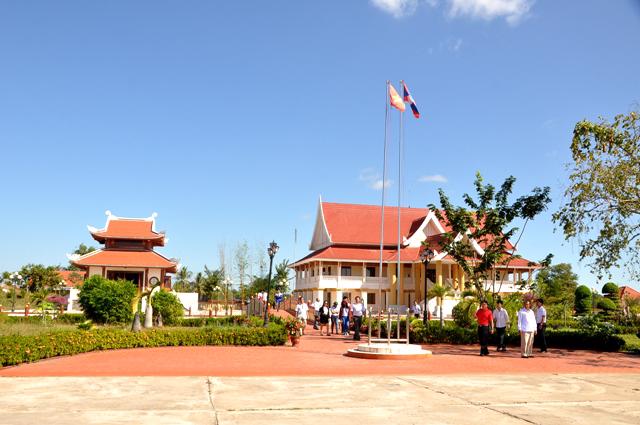
President Ho Chi Minh memorial site in Xieng Vang Village, Xieng Muong Commune, Noong Boc District, Kham Muon Province, Laos. (Photo: VNA)
According to writer Xuvanthon Buphanuvong, Uncle Ho went to Pakse many times, then to Savannakhet, and to Xieng Vang south of Tha Khet town, Kham Muon Province, to directly learn about the situation of Lao people's lives.
During his revolutionary activities, in July 1928, he went to Bangkok, Thailand. Leaving Bangkok, he went north to Noong On village, Udon Thani Province and Nachok village, Nakhon Phanom Province, close to the Mekong River, across from the river being Laos.
During his time working in Thailand under the name Thau Chin (or Mr. Tho), he spent a lot of effort enlightening patriotism for Thai and overseas Vietnamese and selecting the most advanced people to train them to become the core cadres of the movement.
During his active days in Nakhon Phanom, he took a boat many times across the Mekong River to Kham Muon Province (Laos) to Xieng Vang Village, Xieng Muong Commune, Noong Boc District. He met Lao people and overseas Vietnamese living here.
Talking to relatives, he advised the Lao Vietnamese people to unite to help each other, and unite to push the invading French colonialists out of Laos and Vietnam, liberating the two countries from the brutal domination. He also disseminated his experience to Lao-Vietnamese people about the organization of patriotic unions and Lao revolutionary organizations such as Youth Union, Women’s Union and Farmers’ Union.
According to Nguyen Ai Quoc's report to the Executive Committee of the Communist International, he stayed in Thailand until November 1929, after that he went to work in Laos for a short time. From Laos, he intended to return to his homeland, but was pursued by the French colonialists, so he returned to Thailand and secretly went to Hong Kong (China), convening a conference to unify Communist organizations in the country to establish the Communist Party of Vietnam on February 3, 1930.
The Lao Party and Government built a memorial area for President Ho Chi Minh in Xieng Vang Village, Xieng Muong Commune, Noong Boc District, Kham Muon Province, where he used to come to do revolutionary enlightenment activities for the Lao people, greatly contributing to the cause of liberating the Lao people from the slavery of the French colonialists.
The memorial area displays many pictures and artifacts introducing Uncle Ho's life, career and revolutionary activities, as well as his affection for the Lao people.
Especially, in 2013, on the occasion of the 123rd birthday of President Ho Chi Minh, Kaysone Phomvihane Museum built a memorial campus in the center of Kaysone Phomvihane Town, Savannakhet Province, central Laos, with an area of over 1,000 square meters, in which there is a ruby stone printed with the color portrait of President Ho Chi Minh, becoming one of the very attractive tourist attractions of Laos./.